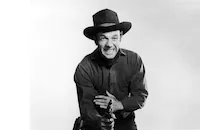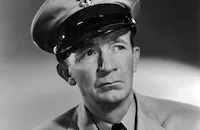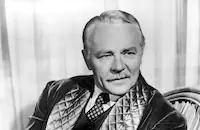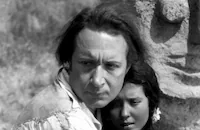A Stolen Life

Brief Synopsis
Cast & Crew
Curtis Bernhardt
Bette Davis
Glenn Ford
Dane Clark
Walter Brennan
Charles Ruggles
Film Details
Technical Specs

Synopsis
When painter Kate Bosworth, who is on her way to visit her cousin Freddie, misses the steamer boat traveling to an island off the coast of Massachusetts, she hitches a ride on a launch driven by handsome Bill Emerson. The launch stops briefly on the island to pick up crotchety Eben Folger, the keeper of the lighthouse on nearby Dragon Head. Determined to see Bill again, Kate talks the reluctant Eben into posing for her by offering him a ship in a bottle that he covets. One day, a heavy fog prevents Kate from leaving, and she stays a while to talk to Bill. Soon the two have fallen in love.
Although Bill is leaving the vicinity temporarily for a new job, he promises to return. Kate's twin sister Pat, who is also visiting the island, meets Bill on the dock and he mistakes her for Kate. Pat pretends to be her sister and has lunch with Bill, who is totally charmed by her vivacious nature. Pat's ruse is revealed when Kate arrives, but later, learning that Bill is going to Boston, Pat takes the same train and continues her acquaintance with him. By the time Bill returns to the island, he and Pat are in love and a short time later, they marry.
After her return to New York, Kate meets unsuccessful artist Karnock, who attacks her work for being stiff and repressed. One day Bill comes to town to tell Kate that he is taking a new job in Chile. Later, Karn, who has been working with Kate, makes a pass at her. Kate realizes that she is is still in love with Bill and decides to return to the island and reflect on her life. When Kate arrives on the island, she finds that Pat is also there, escaping from her bad marriage to Bill. The twins go sailing and, during a storm, their boat crashes on a reef. Kate tries to rescue her drowning sister, but Pat's hands slip away leaving behind her wedding ring. Kate is rescued and the ring convinces everyone that she is Pat. Even after Bill returns from Chile, Kate maintains the pretense, and when she learns that Bill plans to leave her, she begs him for another chance to make the marriage work.
Bill insists that Kate, whom he believes to be Pat, end her affair with Jack Talbot who divorced his wife for Pat. When Kate learns that Pat had many affairs, she is unable to face Bill and leaves for the island. There, she starts to confess her deception to Freddie, who has already guessed the truth and suggests that Kate tell Bill her real identity. She does not have to do this, however, because Bill, who has followed her to the island finally realizes that she is Kate and that he loves her.

Director

Curtis Bernhardt
Cast

Bette Davis

Glenn Ford

Dane Clark

Walter Brennan

Charles Ruggles

Bruce Bennett
Peggy Knudsen
Esther Dale
Clara Blandick
Joan Winfield
Robert Dudley

Jack Mower
Harlan Briggs
Tom Fadden
Lou Mason
Frank Mccarroll
Dale Van Sickle
Sam Ash
Larry Rio
John O'connor
J. Louis Johnson

Monte Blue
Sherman Sanders
A. D. Sewall
Lucille Sewall
Audley Anderson
John Vosper
Claire Meade

Lillian Bronson
Leo White

Paul Panzer
Philo Mccullough
Mary Forbes
George Meader
Creighton Hale
Ruth Cherrington
Frank Darien
Mary Currier
Nell Craig

James Flavin
Mary Servoss
James Notaro
Fred Kelsey
Eddie Searles
Harry Seymour
Rosalie Roy
Paula Ray
Sue Moore
Si Jenks
Crew
Gerald W. Alexander
Russell Collings
E. Roy Davidson
Paul Detlefsen
Rudi Fehr
Leo F. Forbstein
Charles David Forrest
Hugo Friedhofer
Jack Gage
Al Greene
Robert Haas
Ernest Haller
Mario Larrinaga
Robert B. Lee
Fred M. Maclean
William Mcgann
Orry-kelly
Sol Polito
Max Steiner
Catherine Turney
Willard Van Enger
Robert G. Wayne
Perc Westmore
Margaret Buell Wilder

Photo Collections
Videos
Movie Clip




Trailer
Film Details
Technical Specs

Award Nominations
Best Special Effects
Articles
A Stolen Life
When Davis signed a new contract with Warner Bros. in late 1944, part of the deal was that she would produce five films, starting with A Stolen Life, in which she would star. It was an inducement the studio offered stars as a tax dodge, but Davis, unlike such stars as Errol Flynn, took it seriously and insisted on getting involved in such decisions as casting and choosing a director and writer. She had liked the Barbara Stanwyck film, My Reputation (1946), and asked for the director of that film, Curtis Bernhardt and the writer, Catherine Turney, for A Stolen Life. According to Davis biographer Lawrence J. Quirk, the star worked with Turney on the screenplay, putting in some of her own ideas, and giving the character of Kate some of her own characteristics and reactions.
Davis turned down Dennis Morgan for the role of Bill in A Stolen Life, and agreed to cast Robert Alda, but Glenn Ford ended up replacing him. Ford had just gotten out of the marines after serving in World War II, and was under contract to Columbia. Studio head Jack Warner did not want Ford, because he would have to pay Columbia a loan-out fee. But according to Bernhardt, he and Davis "smuggled" Ford on to the Warner lot and made a test with him, which convinced Warner that Ford should play the part. It was his strong performance in A Stolen Life that convinced Columbia to cast Ford in Gilda (1946), which was the film that really launched his career. Years later, when Ford was a big star and Davis was not working much, he cast her as Apple Annie in Pocketful of Miracles (1961). However, he infuriated Davis by telling the press that he cast her as "a favor."
Bernhardt was an autocratic director, who dismissed Davis' producing credit. He later claimed that he was the actual producer of the film. The strong-willed Davis tested him early in the film, as she did most of her directors, but she respected his talent, as he did hers. Bernhardt agreed with Davis that they would not show the differences in twins with different hairdos or clothing styles. Davis knew she could show the women's individuality just by her acting. In spite of any problems they had, Bernhardt later expressed a grudging admiration for Davis. "She is the only actress I knew who didn't leave when her shooting was over. She stayed and watched the other actors working. She was that involved. The hardest thing to do with Bette was to get her faith in you as a director. Once she had faith in a director, she was putty in his hands."
Bernhardt's biggest challenge was the scenes showing the two sisters together. He didn't want to do the usual double exposures, with each sister on her own side of the frame. He wanted them to interact, such as the scene where one sister lights the other's cigarette. So Bernhardt and cinematographer Sol Polito did it with mattes, in which part of the image is masked, and another image is added later. Screenwriter Turney recalled that when she and Davis watched the matte work being done, Davis became upset when the head of the double came off and her own head was added.
Some critics found A Stolen Life gimmicky and preposterous. "It is a distressingly empty piece of show-off for the multi-Oscar® winner to perform," wrote Bosley Crowther in the New York Times. But the public liked it, and even hard-boiled columnist Walter Winchell was moved, calling it "short on logic, but long on heart appeal."
A Stolen Life was the only film Davis would produce, and whether she actually produced or not, her production credit is up there on the screen. Davis' contract stipulated that the name of her production company would appear in the credits. However, the studio had the right to decide how big that credit would be, and while her acting credit is the same size as the title of the film, the words "A B.D. Inc. Production" are a fraction of the size. Warner Brothers made it clear that Davis' value to the studio was on the screen, not behind it.
Director: Curtis Bernhardt
Producer: Bette Davis br> Screenplay: Catherine Turney, Margaret Buell Wilder, based on the novel by Karel J. Benes
Cinematography: Sol Polito, Ernest Haller
Editor: Rudi Fehr
Costume Design: Orry-Kelly
Art Direction: Robert Haas
Music: Max Steiner
Cast: Bette Davis (Kate/Pat), Glenn Ford (Bill Emerson), Dane Clark (Karnock), Walter Brennan (Eben Folger), Charles Ruggles (Freddie Linley), Bruce Bennett (Jack Talbot), Peggy Knudsen (Diedre), Esther Dale (Mrs. Johnson).
by Margarita Landazuri

A Stolen Life
Quotes
Trivia
Notes
A press release notes that the Cape Cod scenes were filmed in Laguna Beach, CA. This film marked the only time that Bette Davis produced her own film, under the B. D. Productions banner. Karel J. Benes' novel was also the basis for the 1939 British film A Stolen Life starring Elisabeth Bergner and Michael Redgrave and directed by Paul Czinner. Although an earlier version of the novel was probably published, the National Union Catalog only lists a 1947 publication date. William McGann and Nathan Levinson were nominated for an Academy Award for Best Special Effects. Bette Davis and Glenn Ford reprised their roles in a Lux Radio Theatre broadcast on August 25, 1947.

Miscellaneous Notes
Released in United States Summer July 6, 1947
Remake of 1939 British film with the same title.
Released in United States Summer July 6, 1947














